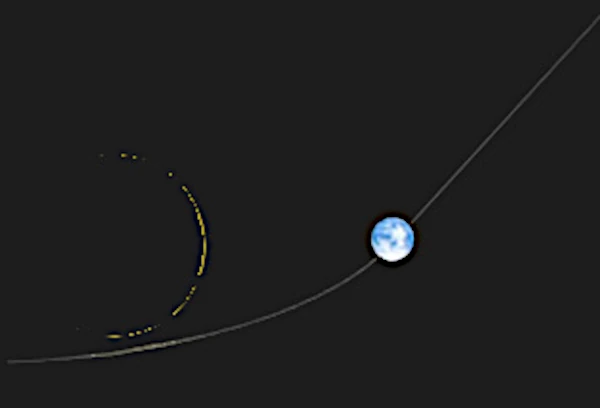
Gravitation, as understood before Einstein, was described by Newton's law of universal gravitation, a force acting instantaneously at a distance. The revolution introduced by Albert Einstein in the early 20th century radically transformed our physical understanding of gravitation, linking it not to a classical force but to the very geometry of spacetime.
In 1905, Einstein published the theory of special relativity, which challenged the classical notions of absolute space and time. It is based on two postulates:
In this framework, spatial and temporal coordinates merge into a four-dimensional continuum called Minkowski spacetime, equipped with a pseudo-Euclidean metric defined by:
$$ds^2 = -c^2 dt^2 + dx^2 + dy^2 + dz^2$$
This metric preserves the invariant interval \(ds\) between two events, thus structuring the reference framework in which particles and fields evolve.
N.B.:
The four-dimensional continuum called Minkowski spacetime is a fundamental concept introduced by Albert Einstein's special relativity and formalized by the mathematician Hermann Minkowski in 1908. It corresponds to a geometric framework unifying space and time into a single mathematical structure with four dimensions: three of space \((x, y, z)\) and one of time \(t\).
N.B.:
A pseudo-Euclidean metric is a distance measurement law where certain dimensions (such as time) have an opposite sign to others (the spatial dimensions). This reflects the intrinsic nature of the relativistic spacetime continuum, where distances can be negative, zero, or positive, depending on their physical meaning.
| Aspect | Newtonian Gravitation | Einstein's General Relativity |
|---|---|---|
| Physical Nature | Attractive force acting at a distance | Dynamic curvature of spacetime |
| Mathematical Framework | Vector calculus in Euclidean space | Tensor calculus in pseudo-Riemannian geometry |
| Propagation | Instantaneous (classical model) | Limited to the speed of light |
| Predicted Effects | Orbital trajectories (approximation) | Light deflection, perihelion precession, gravitational waves |
| Application Domains | Weak conditions, low velocities | Strong fields, relativistic regimes |
Source: Einstein Online - Max Planck Institute for Gravitational Physics, Living Reviews in Relativity, 2016
Special relativity only deals with inertial frames of reference, thus excluding accelerations and gravitational effects. However, gravitation acts precisely on the trajectory of bodies and can be interpreted as an acceleration. To integrate gravitation, Einstein formulates the principle of equivalence:
A uniformly accelerated reference frame is locally equivalent to a reference frame at rest in a gravitational field.
This fundamental idea paves the way for a geometric description of gravitation, distinct from the Newtonian concept of a force acting at a distance.
N.B.:
The principle of equivalence states that gravitation and acceleration are locally indistinguishable. It underpins the idea that a gravitational field is equivalent to a geometric deformation of spacetime, laying the foundations for general relativity.
General relativity, published in 1915, extends special relativity to non-inertial frames of reference and proposes a theory of gravitation based on differential geometry. Spacetime becomes a dynamic object, whose metric \(g_{\mu\nu}\) depends on the distribution of matter and energy. The fundamental law is given by Einstein's equations, a system of nonlinear partial differential equations:
$$G_{\mu\nu} = \frac{8 \pi G}{c^4} T_{\mu\nu}$$
These equations thus express that matter-energy dictates the curvature of spacetime, and this curvature guides the motion of bodies; gravitation is no longer a force but a geometric manifestation.
The physical consequences of general relativity are numerous and have been rigorously tested experimentally:
| Phenomenon | Principle or Equation | Experimental Confirmation |
|---|---|---|
| Deflection of light | Angle θ = 4GM / (c²b) | 1919 Eclipse (Eddington), gravitational lenses |
| Precession of Mercury's perihelion | Δω = (6πGM) / [a(1 - e²)c²] | ~43″/century observed vs Einstein's prediction |
| Gravitational time dilation | Δt′ = Δt √(1 - 2GM / rc²) | Atomic clocks, GPS satellites |
| Gravitational waves | Solutions of the type hμν ≈ A cos(ωt - kx) | LIGO Detection (2015), Virgo, KAGRA |
| Gravitational lenses | Deflection of light geodesics | Multiple images, gravitational arcs, Einstein Cross |
| Gravitational redshift | z = Δλ/λ = GM / rc² | Pound-Rebka Experiment (1960), stellar spectra |
| Relativistic GPS | Combined relativistic correction (SR + GR) | Nanosecond precision |
| Relativistic cosmology | Friedmann equations, FLRW | Measured expansion (Hubble, Planck, SNe Ia) |
| Black holes | Schwarzschild metric: ds² = ... | Accretion, stellar dynamics, EHT image (M87*) |
| Lense-Thirring effect | Precession ∝ J / r³ | Gravity Probe B (2011) |
The complete physical understanding of Einstein's theory of gravitation is very complex, as it relies on a sophisticated and highly geometric mathematical structure that requires mastery of the following concepts:
gμνRρσμνRμν and Ricci scalar RGμν = Rμν - ½ R gμνδS = δ∫√(-g) R d⁴x = 0(Tμν).Conclusion: General relativity is a geometric theory of gravitation, mathematically sophisticated but extraordinarily predictive.
This is why its complete understanding remains today reserved for a small circle of physicists trained in these tools, although its consequences (GPS, black holes, cosmology) are observable and experimentally confirmed.
Einstein's theory of gravitation is based on a profound reformulation of the structure of the Universe, founded on several essential physical principles:
These foundations imply a dynamic universe where spacetime evolves according to the distribution of matter-energy, paving the way for a relativistic cosmology capable of explaining the expansion of the Universe, the Big Bang, and black holes as natural solutions to Einstein's equations.